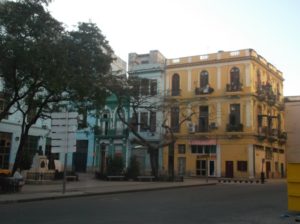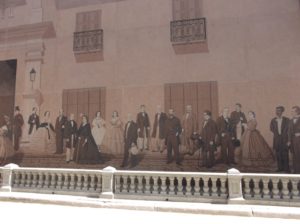Locale: Founded in 1519 (which means a quincentenary celebration is in the works!), the capital of Cuba is officially named San Cristóbal de la Habana. The city’s harbor was the gathering place for Spanish galleons which carried the treasures of the New World back to Imperial Spain.
Old Havana, with its narrow streets and overhanging balconies, is the traditional city center and is particularly rich in its architectural heritage. On our morning walk, we saw some fabulous buildings, including the Barcardi Building, built in 1930 and a beautiful example of Art Deco architecture, the Museo Nacional de Bellas Artes, and the baroque Great Theater of Havana built in 1837 and now home of the world-renowned National Ballet of Cuba. Old Havana was declared a UNESCO World Heritage Site in 1982; unfortunately, many parts of Old Havana are crumbling and in disrepair.
But there’s good news too. According to a Wikipedia article:
Havana, on average, has the country’s highest incomes and human development indicators. After the collapse of the Soviet Union [in 1989], Cuba re-emphasized tourism as a major industry leading to its recovery. Tourism is now Havana and Cuba’s primary economic source.
The city has a population of over 2 million people and attracts over 1 million tourists annually.
Our mid-morning walk through the Old City took us to the four main squares.
Plaza de San Francisco on Avenida del Puerto at Amargura: This is one of the four leading plazas laid out in the 17th century. The spacious cobbled square, which was fully restored in the 1990s, takes its current name from the Franciscan convent built there. Today the basilica dominates the square to the south, while to the north is the Neoclassical Lonja del Comercio (“Commercial Exchange”), dating from 1907 and topped by a bronze image of a winged Mercury. More modern additions include a luxurious boutique hotel plus restaurants, some notable art pieces, including bronze figures of Polish composer Chopin and a famous Havana tramp, El Caballero de Paris, of the pre-Revolutionary decades. To the square’s southeast corner, the Carrara marble Fuente de los Leones was sculpted in 1836 by Italian artist Giuseppe Gaggini.
Plaza Vieja: The plaza was originally called Plaza Nueva (“New Square”). In the eighteenth century the square was turned into a popular market, and as Plaza del Mercado (“Market Square”) it was Havana’s commercial hub. In 1814, with the birth of the Mercado Nuevo (“New Market”) in the Plaza del Cristo, the Old Square was renamed to differentiate it. Buildings surrounding this square were constructed in various architectural styles: Colonial, Baroque, Neoclassical, Art Deco.
Plaza de Armas: In colonial times, this square was the site of military parades, musical concerts, and formal evening promenades. Surrounded by buildings spanning four centuries, it maintained its political and administrative role until the mid-20th century. In the center of the square is Parque Céspedes, anchored by a white marble statue of Carlos Manuel de Céspedes, initiator of the Cuban Wars of Independence and “Father of the Homeland.” Surrounded by royal palms (Cuba’s national tree) and ceiba trees, the statue was made by Cuban artist Sergio López Mesa. Also situated in this area is La Giraldilla, dated 1634 and the symbol of the city. I was interested to hear that the granite for the Palacio de los Capitanes is actually from my home state of Massachusetts; it was carried here as ship ballast (I might have gotten this detail wrong, as other sources state that the building stone came from the infamous San Lázaro Quarry).
Plaza de la Catedral: This is another of the main squares in Old Havana and the site of the Cathedral of Havana from which it takes its name. Originally a swamp, it was later drained and used as a naval dockyard. Following the construction of the Cathedral in 1727, it became the site of some of the city’s grandest mansions. The resplendent Palacio de los Condes de Casa Bayona is now the site of the Museo del Arte Colonial. Christopher Columbus was interred in the cathedral until 1898, when his remains were removed and transferred to Seville in Spain. This is the newest of the four squares we toured today.
Other notable sights on our walks included these: Capitolio Nacional, El Floridita Bar, the Coche Mambí, Museo del Chocolate, Maternity Hospital, Museo de Armería, Hotel Ambos Mundo of Ernest Hemingway fame, restaurant La Bodeguita del Medio, nineteenth century pharmacy Farmacia y Droguería Taquechel.
Weather: 80s. Sunny.
Itinerary: In and around La Habana
Overnight: Meliá Cohíba
Excursions: Sunrise in Old Havana 6-8 am, breakfast at Hotel Inglaterra, visit shop at Museo de Ron, tour of historic city, lunch at La Moneda Cubana, group photo on the Malecón, visit La Feria indoor market, visit Hotel Nacional, joyride in classic American cars, visit bodega, dinner at Tres Monedas # 209 Aguiar, music show at Meliá Cohíba Habana Café
Habitat: Urban
Bird Species: Antillean Palm Swift (Tachornis phoenicobia)
Guides and Driver: Angel, David, Liu and Carlos
Observations: On our early morning walk, we saw public school students in their color-coded uniforms, milling about in front of the school building, acting like kids everywhere. No matter your opinion on Cuba’s socialist revolution and its stifling of civil liberties, its achievements in education, literacy, universal health care, and public safety are undeniable.
I stopped taking notes quite soon after our Cuban National Guide began rattling off facts and figures for us, because there was just too much information! So don’t rely on this blog post for an accurate account of Havana history.
The paladar where we had lunch also trains Cubans for employment in the hospitality industry; there were brochures on our tables describing the program (“the business owner and a government representative modeled a training program for unemployed young people in order to train them as future waiters and waitresses”).
Designed by American architecture firm McKim Mead and White, the Hotel Nacional de Cuba, located on the Malecón and Taganana Hill, has a storied history. I didn’t see the bullet holes in the walls though. We weren’t supposed to, but we wandered into the room with the Wall of Fame to gape at the photos of celebrities.
Our dinner at Tres Monedas was probably the most upscale meal we had; I particularly liked the welcome drink which tasted like sangría.
I don’t think I was at all familiar with the Buena Vista Social Club, so I looked it up afterwards. Here’s what an opinion piece in the NY Times says: “That collection of antique Cuban dance music of the 1930s, ’40s and ’50s, made by a makeshift group of musicians from across the island, was so popular it led to a world tour, some Grammys, a Carnegie Hall concert, a film, then spinoff records and spinoff tours.” The Guardian echoes this ambivalence: “The Buena Vista phenomenon has created a huge number of copycat bands. You’ll hear the same songs everywhere – Chan Chan, Dos Gardenias. It’s as if it has become a parody to cater to tourists. The Buena Vista collective was very much an artificial creation, a record-company creation, and its rise coincided with the rise of tourism, the collapse of the Soviet Union, and all sorts of legal changes that had started to connect Cuba to the capitalist world.”
Although I don’t generally care for any music except opera, I really enjoyed the music and dance performance. Gosh, I wish I had the body of those young female dancers . . .
Reflections: A performance of Cuban music would not be complete without “Guantanamera” — the lyrics are by famed Cuban patriot José Martí.
Yo soy un hombre sincero
De donde crece la palma,
Y antes de morir yo quiero
Echar mis versos del alma.
Mi verso es de un verde claro
Y de un carmín encendido:
Mi verso es un ciervo herido
Que busca en el monte amparo.
Cultivo una rosa blanca
En julio como enero,
Para el amigo sincero
Que me da su mano franca.
Con los pobres de la tierra
Quiero yo mi suerte echar:
El arroyo de la sierra
Me complace más que el mar.
I was a sixties radical (or rather, radical wanna-be) and loved this song, probably as performed by the Sandpipers, though it was covered by everyone from Pete Seeger to Joan Baez. Whenever I heard it here in Cuba this past week, it felt less languorous and sorrowful than I remembered it.
Images:

You can hardly see it in this photo, but this is Fidel’s boat, the Granma.

Perhaps this building was occupied by squatters, in the early days of the Revolution.

Morning light is gilding this little square in the old city.

I tried photographing the lobby of the Bacardi Building.

The Bacardi Building’s exterior features a facade of red granite, golden glazed tiles, brass fixtures, and colorful terracotta reliefs.

The CDR is a neighborhood-based group; as “Number 6,” this is one of the earliest.

Didn’t they do a great job on this restoration?

American tourists enjoy seeing this bar which Hemingway frequented.

The Gran Teatro de La Habana is the home of the Ballet Nacional de Cuba.

Bronze lions guard the Paseo del Prado.

We visited the tienda of the Museo del Ron but were not able to purchase bitters.

Sculpture of a nude woman astride a chicken holding a fork: what can it mean?

These lovely buildings surround the Plaza Vieja.

This nineteenth century pharmacy is still in business.

The statue of Carlos Manuel de Céspedes graces the Plaza de Armas.

This mural by Cuban artist Andrés Carillo is across from the Palacio del Marqués de Arcos.

Havana Cathedral, in the Plaza de la Catedral, is considered one of the best examples of Baroque architecture in Cuba.

I think this is Moro Fort, viewed from the Malecón.

The Hotel Nacional is backlit by the late afternoon sun.

Royal palms flank the entrance to the Hotel Nacional, a civic landmark.

We rode in a red ’54 Chevy, a car as old as I am!

A Buena Vista Social Club tribute band entertains at the hotel’s Habana Café.